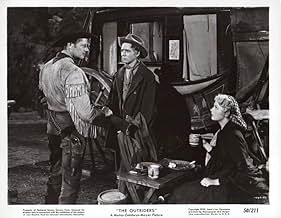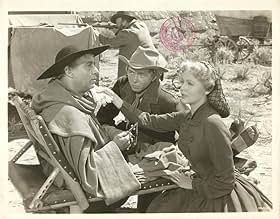Ajouter une intrigue dans votre langueIn 1865, three escaped Confederate POWs are coerced into joining an offshoot of Quantrill's raiders who are planning to rob a Union gold shipment concealed in a civilian wagon train going fr... Tout lireIn 1865, three escaped Confederate POWs are coerced into joining an offshoot of Quantrill's raiders who are planning to rob a Union gold shipment concealed in a civilian wagon train going from Santa Fe to St. Louis.In 1865, three escaped Confederate POWs are coerced into joining an offshoot of Quantrill's raiders who are planning to rob a Union gold shipment concealed in a civilian wagon train going from Santa Fe to St. Louis.
- Farmer's Wife
- (non crédité)
- Outrider
- (non crédité)
- Farmer's Son
- (non crédité)
- Prisoner
- (non crédité)
- Boy Telling About the War
- (non crédité)
- Wagon Driver
- (non crédité)
- Prisoner
- (non crédité)
- Ross
- (non crédité)
- Outrider
- (non crédité)
Avis à la une
The same can be said of other MGM films from the late 1940's and early 1950's that I've seen. RKO, 20th Century-Fox, or Paramount would have made this film in a more exciting and engaging manner. For some reason, MGM films from around this time tended to pull their punches.
The Outriders was a typical late '40s western movie, so the only reason I decided to watch it was that I like Joel McRea. Otherwise I might have passed on this 55 year old sage brush saga. But once it started, the female lead, Arlene Dahl, caught my eye.
Ms. Dahl could have been just another late 1940s blonde, blue eyed movie star in another late 1940s oater except for two things. first, she looked uncannily like my high school sweetheart (I know, everyone has an old high school sweetheart-go watch American Graffiti) but she really did look like her. And secondly, she spoke softly and moved, glided across the stage, just like *** did.
Then the story line somewhat mirrored the relationship we had. A tough and dangerous outlaw meets a sweet, honest and stunning beauty. I let myself slip into the fantasy of this movie figuring it would be a nice bit of nostalgic escapism. but then came the dance scene during the wagon train's stop on its overland journey.
Head honcho Will Owens (McRea) tells Jen Gort (Ms. Dahl) to stay in the wagon to avoid getting the trail hands stirred up, but when the men break out fiddles and guitars and start singing around the camp fire, she comes out, dressed to the nines with her dancing shoes. Jen glides effortlessly across the camera's view and dances with all the men, politely and dignified, yet strikingly alluring and all woman.
But what touched me was when she told Will Owens "you wanted me the most". No modern day tawdriness; nor erotic film scene with naked, sweating bodies could convey the message any clearer than her voice, her eyes and those words. It took me back.
This film may just be another fast paced western to most, but to me it is **** and me. I miss her.
This Western is a superior outing because it displays thrills , emotion , shoot'em up , brawls , intrigue , riding pursuits and many other things . There is filled with action in the movie , guaranteeing some shots or stunts every few minutes . Interesing and moving screenplay by Irving Ravetch based on his own story . Here filmmaker Roy Rowland delivers a nice film , however he could be counted on to deliver solid "B" pictures which, at MGM, were often better than most other studios' "A" pictures . Brief character studio about three escorts or outriders , Joel McCrea/Barry Sullivan/James Withmore they became friends despite their differing personalities , until the inevitable final conflict . The highlights of the movie are the spectacular as well as violent getaway from Benton Missouri Camp and the sensitive dance between Arlene Dahl and the sex-hungry soldiers . Very good support cast such as James Whitmore , Ramon Novarro , Jeff Corey , Alex Montoya , Ted De Corsia and a young Claude Jarman Jr of Rio Grande and The yearling . Colorful as well as evocative cinematography by Charles Edgar Schoenbaum supported by expert cameraman Henry Jaffa . Adequate and atmospheric production design by Cedric Gibbons , MGM's usual , though also contains abundant matte paintings . Rousing and breathtaking musical score by Andre Previn who married Mia Farrow
The motion picture lavishly produced by Richard Goldstone and MGM studios was well directed by Roy Rowland . He sharpened his directing chops at MGM with a series of shorts starting in the 1930s, then moved up to features in 1943 . Roy spent quite a bit of time at the studio, from 1943-51 and again from 1954-58 ; he had the good fortune to marry the niece of Louis B. Mayer and was the father of actor Steve Rowland . While not one of the studio's top-rank directors , he was a good professional who had a considerable success . Most were B-movies, but he occasionally handled such A-graders . His greatest hit was , of course , the fantasy movie titled The 5000 fingers of Dr T (1953) . Rowland made an action picture for independent release based on a Mickey Spillane "Mike Hammer" novel starring Spillane himself (Girl hunters (1963)) . He specialized in a variety of genres, including musicals : ¡Viva Las Vegas! (1956) The seven hills of Rome (57) , Two weeks with love (50) and dramas : Our wines have tender grapes 45 with Edward G Robinson (1945). He was also responsible for the tough, fast-paced Rogue Cop (1954), one of the few MGM films that could be considered "film noir". Roy was a Western expert , as the last film he made at MGM was a "B" western with Stewart Granger, Gun Glory (1957); besides , he filmed Bugles in the afternoon with Ray Milland and Many rivers to cross with Robert Taylor ; after which and then he traveled to Europe for a string of Spanish/Italian-made westerns such as Los Pistoleros De Casa Grande and Ley Del Forastero . His final film as director was a somewhat cheesy pirate movie (he was uncredited ; his Italian co-director Sergio Bergonzelli got sole credit) called El Tigre De Los 7 Mares and its sequel : Tormenta Sobre el Pacífico (1966). He was associate producer on Nathan Juran's Italian-shot Al Infierno, gringo (1969), after which he retired.
The other virtue of the studio system is the stable of professional actors who perform their roles not to steal scenes but in service of the plot. Joel McCrea may excel even Randolph Scott in saying the most with the least words while never ever lying--the Western-hero actors of their generation internalized completely the cowboy as a latter-day knight, and the alchemy of script and star is fascinating. Arlene Dahl may be even more economical with her speech than McCrea. In the central dance scene she speaks not a word until a critical moment, then agrees to dance with McCrea only if he bows to put fresh shoes on her feet. The scene is all about sex, but the actors, the script, the direction, and the genre completely control the sexuality's expression.
In the supporting ranks James Whitmore, not yet 30, is convincing as an old-coot warrior-sidekick with kidney trouble, while Ramon Navarro--a former sex symbol entering his 50s--plays a Mexican padrone who's still got chops. Barry Sullivan and Jeff Corey remain menacing even when they're acting cooperative. Claude Jarman, Jr. is always worth watching but the director or editor seemed to forget he was in the movie.
I couldn't stop watching, but the less-enthusiastic reviewers have a point. The film fulfills its genre so professionally that it never falls below a certain level. But those same qualities make its most beautiful moments somewhat understated, like something even better might once have been imagined but for now they need to finish a movie.
Here to the premise is three men who also go their separate ways as a result of the Civil War. Here the shared experience is prison camp. Joel McCrea, Barry Sullivan, and James Whitmore are Confederate prisoners who escape in early 1865. In effecting their escape they fall into the hands of a rebel guerrilla leader played by Jeff Corey.
Being guerrillas these guys don't play by the rules. The trio either goes west to Santa Fe to act as Judas goats and lead a gold train into ambush or die right there. Even the always honorable Joel McCrea sees he has no options here.
The rest of the story is how the conflicts internal and external are resolved and how the three escaped prisoners decide what course they have to take. Oh, and Joel McCrea meets up with Arlene Dahl and she kind of helps him along in the decision process.
The movies never had a more honorable or stalwart hero than Joel McCrea. And if you've seen any of his films, fans will know that whatever he does it will be the honorable thing. It's a tribute to McCrea that if he insisted on always being the stalwart hero, he had the talent and personality to carry it off.
It's familiar ground for Joel McCrea, but western fans will like the story and the gorgeous technicolor photography that captures it.
Le saviez-vous
- GaffesWhen Will puts Jen's shoes on her, she is wearing sheer stockings. In the 19th Century, since hemlines were ground level, and ankles could not be seen, sheer stockings would have been pointless. Silk and rayon stockings only came about in the 1920's (and nylon in the 1940's) when hemlines rose and showed off a woman's ankles and calves. In the 1860, women's stockings would have been either wool or cotton, and what Jen is wearing when Will puts her shoes on her feet are sheer and NOT wool or cotton.
- Citations
Clint Priest: Me, I kinda relish gettin' old... takes the bother out of livin'.
- ConnexionsReferenced in Amour et caméra (1950)
Meilleurs choix
- How long is The Outriders?Alimenté par Alexa
Détails
Box-office
- Budget
- 1 621 000 $US (estimé)
- Durée
- 1h 33min(93 min)
- Rapport de forme
- 1.37 : 1





































